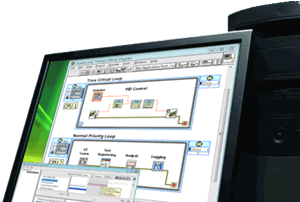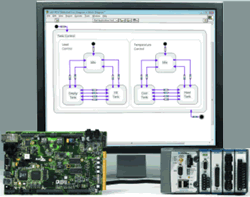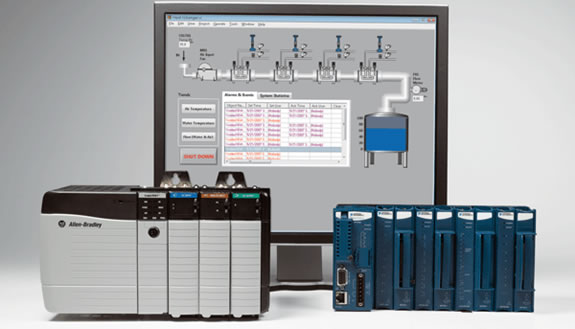NI Delivers LabVIEW 8.5
Newest release of graphical development system introduces statechart design and new analysis functions for industrial monitoring and control.
August 8, 2007
By Anthony J. Lockwood
August 8, 2007 —  National Instruments (NI; Austin, TX) has announced LabVIEW 8.5, the newest release of its graphical system design platform for test, control, and embedded system application development. Key enhancements include simplified support for mapping applications to multicore processors as well as new a statechart design module. Additionally, LabVIEW 8.5 has new I/O libraries and new analysis functions for industrial monitoring and control.
National Instruments (NI; Austin, TX) has announced LabVIEW 8.5, the newest release of its graphical system design platform for test, control, and embedded system application development. Key enhancements include simplified support for mapping applications to multicore processors as well as new a statechart design module. Additionally, LabVIEW 8.5 has new I/O libraries and new analysis functions for industrial monitoring and control.
LabVIEW’s parallel dataflow language means that version 8.5 inherently supports next-generation multicore processors and FPGA-based systems by enabling you to map your applications to multicore and FPGA architectures “easily,” in NI’s words. LabVIEW 8.5 builds on the automatic multithreading capability of its predecessors by scaling your applications to the total number of cores available. Further, it offers enhanced thread-safe drivers and libraries, reported to improve throughput for RF, high-speed digital I/O, and mixed-signal test applications.
With the LabVIEW Real-Time environment, LabVIEW 8.5 also delivers SMP (symmetric multiprocessing). This capability enables embedded and industrial system designers to load-balance tasks across multiple cores automatically and without sacrificing determinism. For fine-tuning real-time systems or isolating time-critical sections of code on a dedicated core, Version 8.5 lets you manually assign portions of code to specific processor cores. For real-time multicore debugging and code optimization, NI offers the Real-Time Execution Trace Toolkit 2.0. This toolkit provides you with the means to visually display timing relationships between sections of code and the individual threads and processing cores where the code executes.
NI says that LabVIEW 8.5’s enhanced FPGA Project Wizard continues the company’s tradition of simplifying your FPGA programming jobs. The FPGA Project Wizard automates I/O configuration, IP development, and overall setup for common I/O, counter/timer, and encoder applications. With it, according to NI, you can automate the generation of complex high-speed DMA data transfer code. The new Statechart Module for LabVIEW 8.5 is based on both the LabVIEW graphical programming language and familiar, high-level UML (unified modeling language) standard statechart notations. Using this module, you can design as well as simulate the behavior of real-time and embedded systems for such applications as digital communication protocols, machine controllers, and system-protection. Additionally, since the Statechart Module leverages LabVIEW, you can combine statechart notation with real-world I/O running on deterministic real-time or FPGA-based systems. Ultimately, this means that the LabVIEW Statechart Module creates a single platform environment from which you design, prototype, and deploy your systems.
The new Statechart Module for LabVIEW 8.5 is based on both the LabVIEW graphical programming language and familiar, high-level UML (unified modeling language) standard statechart notations. Using this module, you can design as well as simulate the behavior of real-time and embedded systems for such applications as digital communication protocols, machine controllers, and system-protection. Additionally, since the Statechart Module leverages LabVIEW, you can combine statechart notation with real-world I/O running on deterministic real-time or FPGA-based systems. Ultimately, this means that the LabVIEW Statechart Module creates a single platform environment from which you design, prototype, and deploy your systems.
For some time now, LabVIEW has enabled you to integrate existing PLC (programmable logic controllers) based industrial systems with more advanced PACs (programmable automation controllers) by adding high-speed I/O and complex control logic to your industrial systems. LabVIEW 8.5 extends this capability with a number of I/O, measurement, and display enhancements for building PAC-based industrial systems. By way of example, version 8.5 offers a new library of OPC drivers that expands industrial connectivity for LabVIEW users by nearly doubling the number of compatible PLCs and industrial devices.
LabVIEW 8.5 also adds vibration and order tracking measurements and machine vision algorithms for industrial machine monitoring systems. For high-channel-count systems, the new multivariable editor facilitates the configuration and editing of I/O tags with its simple, spreadsheet interface. Additionally, version 8.5 introduces new flexible pipe display tools, which NI says simplifies the process of building more realistic industrial user interfaces. Version 8.5 also offers an interactive drag-and-drop approach to tie I/O tags directly to user interface displays running on Windows CE-based industrial touch panels and handheld PDAs.
Miscellaneous LabVIEW 8.5 enhancements include support for Freescale ColdFire processors; project file-management tools and graphical code merging for team-based development; new, optimized BLAS linear algebra libraries; and improved edge detection for image processing as well as optimized algorithms for various demodulators and channel coding schemes.

LabVIEW 8.5 is available in versions for Windows, Macintosh, and Linux systems. Pricing ranges from $1,199 to $4,099, depending upon capabilities of your application development environment. (LabVIEW service maintenance and support program members will receive LabVIEW 8.5 automatically in the mail or via a download.)
Click here to sign up for a three-hour online evaluation of the LabVIEW Professional Development Environment. The online evaluation does not require downloading or installing the software. The evaluation includes a guided tutorial with hands-on exercises as additional resources and code samples. To sign up for an on-demand webcast of LabVIEW 8.5, click here.
For complete details on LabVIEW 8.5 as well as free access to a variety of videos demonstrating LabVIEW features by such applications as automated test, data acquisition, embedded design, and machine control, click here.
Subscribe to our FREE magazine, FREE email newsletters or both!
About the Author
Anthony J. Lockwood is Digital Engineering’s founding editor. He is now retired. Contact him via [email protected].
Follow DE





